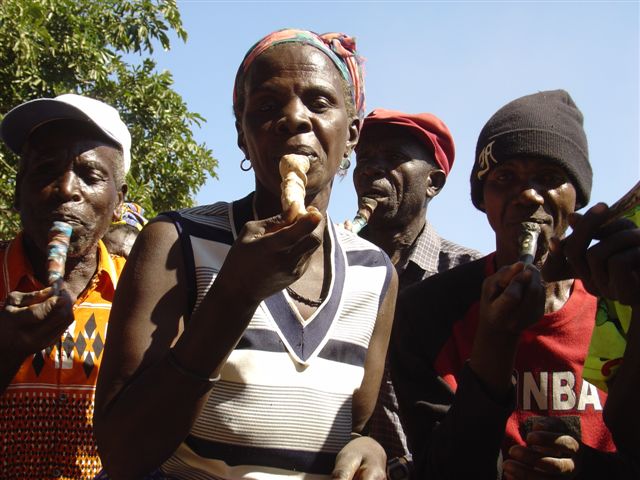
Photo: Maliko © Peter Kuthan
Die 30 Tonga MusikerInnen spielen einen der wirklich großartigsten Musikstile Afrikas, in dem zwischen fünf und sieben verschieden große Trommeln (ngoma) und an die dreißig individuelle Blasinstrumente aus Antilopenhorn (nyele) gespielt werden. So trägt jede(r) Einzelne zu einem einzigartigen Klanggewebe bei, das für unsere Ohren gleichzeitig archaisch und avantgardistisch klingt.
Ngoma buntibe hat viel mit bewegter Musik im akustischen Raum zu tun und wirkt damit selbst im Setting westlicher, zeitgenössischer Musik keineswegs deplatziert. Wie das Zusammenspiel der MusikerInnen, die offenbar nach Trommelgrößen, Rasseln oder Länge bzw. Tonhöhe der Antilopenhörner gruppiert sind, zustande kommt, ist für den Betrachter so unerfindlich wie die Choreografie ihrer stampfenden Bewegungen, ihr plötzlicher Stillstand, die angedeuteten Jagdszenen oder die Gesänge und Rasseln der Frauen, die sie umkreisen.
MusikerInnen / Musicians Simonga:
Siapawa Mombe, Margret Moombe, Well Muleya, Martin Munenge, Peter Mungombe, Sialwindi Munkuli, Lundu Munkuli, Mbobola Munkuli, Siamilandu Munkuli, Dick Munkuli, Janete Muzamba, Siakuba Mwinde, John Siachilete, Bertha Siamdenda, Vincent Siankuni
MusikerInnen / Musicians Maliko:
Selina Chilolo, Moses Kandongwe, Louis Maanje, Siaminwe Milandu, David Mundando, Bedford Siakachala, Ever Sialumbuka, Elison Siamuchiliba, Benson Siamukumbwa, Agness Siamunyembe, David Siankusule, Zilo Sikaputa, David Simachaina, Million Singwinda, Nelson Syachingulwe
Zur Tonga Tonkunst:
“One man One Note” from Keith Goddard:
“The drums began and as the horns started up in response, my ears were flooded by the most extraordinary texture of sound. I was in the middle of rural Zimbabwe where even Lion beer and castle lager and CocaCola had failed to penetrate to any great extent and I was hearing music that made Stockhausen sound like lullabies. I couldn’t decide whether it was most like the micro-polyphony of Ligeti, the serial universe of Stockhausen or the aleatorism of Cage. There were about fifteen to twenty horns, smaller higher ones and longer deeper ones. Each player blew one horn, contributing a single pitch to the musical texture as and when it was required in the phrase.
I could hear no recurring pattern, sense no periodic rhythm and feel no beat despite the constant jogging on the spot by the horn players and singers. Everything happened in great swirls. I was caught inside a traffic jam of hooters and a whirlpool of women dancing and singing with great force. At times, the horn players would break away and move off into the distance, often dragging me or one of the film crew with them. When this happened, the drums would settle down to a modest tapping, keeping the basic pattern going. When the horns returned, their approach was welcomed by an upsurge in energy and the cheerful noise would start up once more.
Although I was baffled by what I was hearing, the fifties avant garde was a firm part of my soundworld and through my experience of it I seriously doubted that Tonga nyele was a random noise. Since then, over the past ten years, I have spent frequent though short stays in the area, mostly around Siachilaba, listening to Valley Tonga music and trying to come to grips with it.
more: http://www.mulonga.net/index.php?option=com_content&task=view&id=219&Itemid=93
In Kooperation mit / In cooperation with Kunzwana Trust


[...] infos on the Parade/Linz09 or on the Simonga-maliko here [...]
[...] Austria. Length of the recording: 4:30 More infos on the Parade/Linz09 or on the Simonga-maliko here [...]